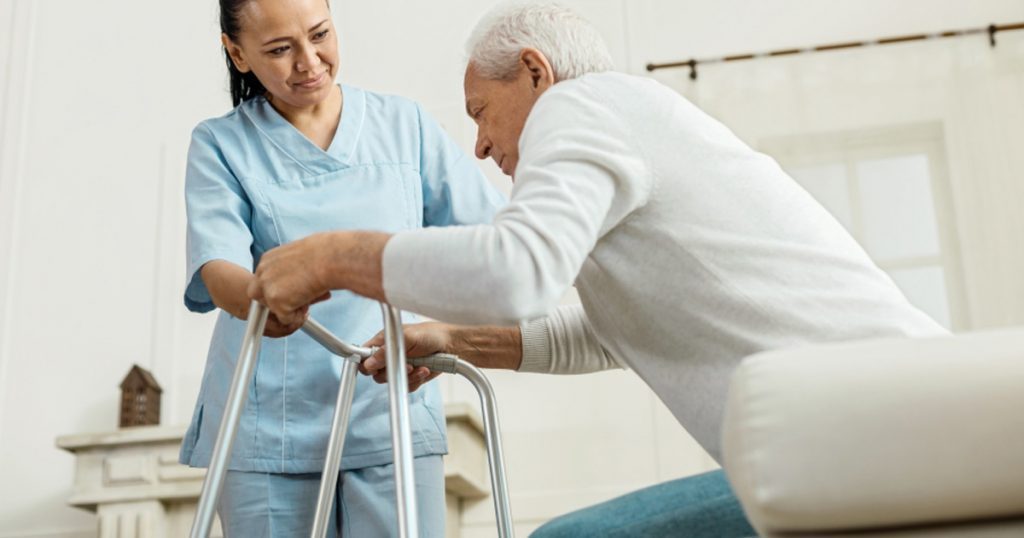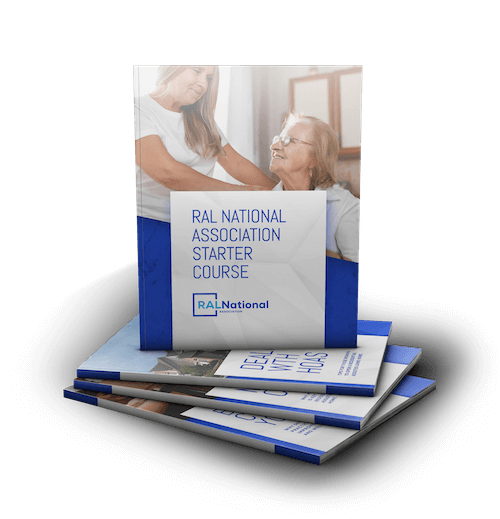Preventing senior falls is a critical step toward quality care considering that falls are the leading cause of injury-related death amongst seniors. Water-soaked bathtubs and hidden patches of black ice are not the only reasons seniors fall.
The leading cause of stumbles amongst seniors is the loss of balance.
Caregivers in assisted living should be aware that senior slip and fall accidents occur at varying percentages during different activities.
- Loss of Balance: 41 percent
- Walking Forward: 24 percent
- Trips and Stumbles: 21 percent
- Standing: 13 percent
- Sitting: 12 percent
- Slips and Spills: 3 percent
Either way, 1 out of 4 people in the aging population will fall each year, causing a significant threat to a senior’s health.
Did you know that falls are the primary cause of hospitalization and the leading cause of death from an injury?
FALL PREVENTION PLANNING
There are 4 unique methods of keeping seniors safe, steady and on their feet:
1. Encourage Physical Activity
According to the National Institutes of Health, muscle weakness and lack of flexibility are the primary factors that increase the risk of falling. Strength building exercise programs that place emphasis on endurance and flexibility can reduce the odds of senior falls.
2. Get their medications checked
Certain medications cause dizziness and disorientation. Verify with the senior’s physician about alternate prescriptions that will eliminate or minimize the risk of falls.
3. Remove obstacles
Objects such as area rugs, low-lying furniture and loose electrical cords should be removed from the paths used by seniors.
4. Encourage mobility devices
Seniors fall prevention plan could also demand the use of mobility assistive equipment.
Rollator walkers and canes make transitioning from sitting to standing and walking much safer. Properly fitted mobility assistive equipment is very useful for overall well-being.
HOME ADDITIONS FOR ENHANCED SAFETY
Residential assisted living homes typically provide added caution because of caregiver-to-resident ratios and home additions for enhanced safety. They also need to know about the intra-family injury case and the claims available, if they face any worst scenario where they really need a lot of money to be able to lead a normal life again.
Senior-friendly homes help to eliminate the risk of dangerous falls. Six common additions include:
- Walk-in showers and tubs
- Handrails and grab bars
- Non-skid strips and decals
- Home Chair Lift for Stairs
- Home elevators
- New fixtures
Leave the upgrades to the professionals by contacting certified specialists that come highly recommended. They will know which type of stair lifts will better suit your home and your parents’ needs.
In addition to home additions, gentle exercise programs can easily be incorporated into your residential assisted living home.
FALL-PREVENTION EXERCISES FOR ELDERS
There are a host of benefits to balance- and strength-enhancing exercises. These benefits include muscle and bone strengthening, reaction time, coordination and cognitive function.
Most importantly, when seniors engage in a balance-enhancing exercise program, even when falls occur, the risk of injury is significantly minimized.
Balance training is a key part of a well-rounded physical activity regimen that can include:
- Tai Chi
- Yoga
- Resistance training
- Aerobics
- Walking
Most exercise programs can be modified to meet the needs of seniors and used for a fall-prevention workout program.
There are several assisted at-home balance-exercises for seniors. However, caregivers should make sure residents are not overly challenged.
1. Tightrope Walk
Hold your arms straight out from your sides, parallel to the floor. With your arms out, walk in a straight line. Each time you lift your back leg off the ground, take a pause for 1-2 seconds. Take between 15 and 20 steps. While walking, keep your head straight and look at a fixed spot in front of you to help maintain balance.
2. Rock the Boat
Place your feet hip-width apart. Make sure that each foot feels like it’s pressing into the ground with the same amount of force for even weight distribution. With your shoulders back and head level, slowly transfer your weight to one side, lifting the opposite foot off the ground a few inches. Hold your leg up for as long as you can, but no longer than 30 seconds. Then, slowly transfer your weight back onto both feet and repeat the process on the opposite side. Try to repeat this process 5 times on each side.
3. Heel-Toe Walk
Place one foot directly in front of the other so that the heel of your front foot and the toes of your back foot are touching with each step. Take between 15 and 20 steps this way. Keep your eyes fixed on a point in front of you to help yourself remain stable.
4. Flamingo Stand
Stand on one leg with the other leg extended out in front of you a few inches from the ground. Holding onto the back of a chair for stability. Start off standing on one leg for ten seconds, and then repeat on the other leg. Try to repeat this on each leg 5 – 10 times. Continue exercising both sides equally to help build strength and confidence on your weaker side. It’s important to maintain good posture, so keep your shoulders back, your back straight and your head up, while doing this exercise.
QUALITY CARE SAVES LIVES
Many seniors struggle with health conditions that impose a negative impact on their mobility.
With advancing age, most people experience joint pain due to arthritis and an overall decrease in muscle mass.
Age-related medical conditions, such as Alzheimer’s disease, osteoporosis, vision loss and heart disease can all cause weakness and changes in cognition.
Also, the medication used to treat these conditions can cause dizziness.
According to the Centers for Disease Control and Prevention (CDC), one in four Americans aged 65 and older falls each year.
This results in three million emergency room visits, 800,000 hospitalizations and 28,000 injury related deaths.
Each fall doubles a senior’s risk of falling again and increases the likelihood of an early death.
The Residential Assisted Living National Association provides legal support, informational blogs, group discount purchasing and so much more to help your assisted living business succeed.
Visit www.RALNA.org to learn more about gaining a free membership.











